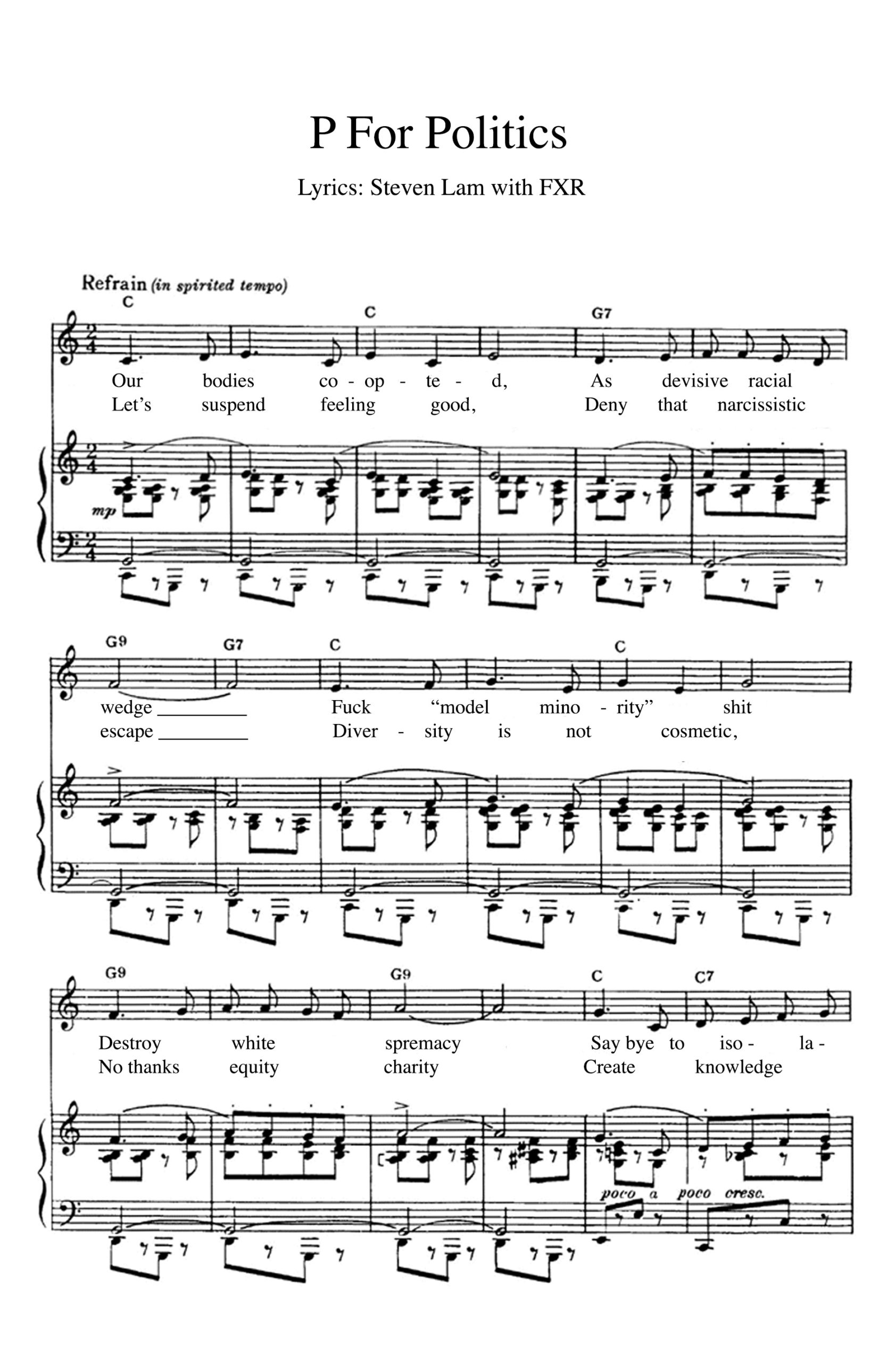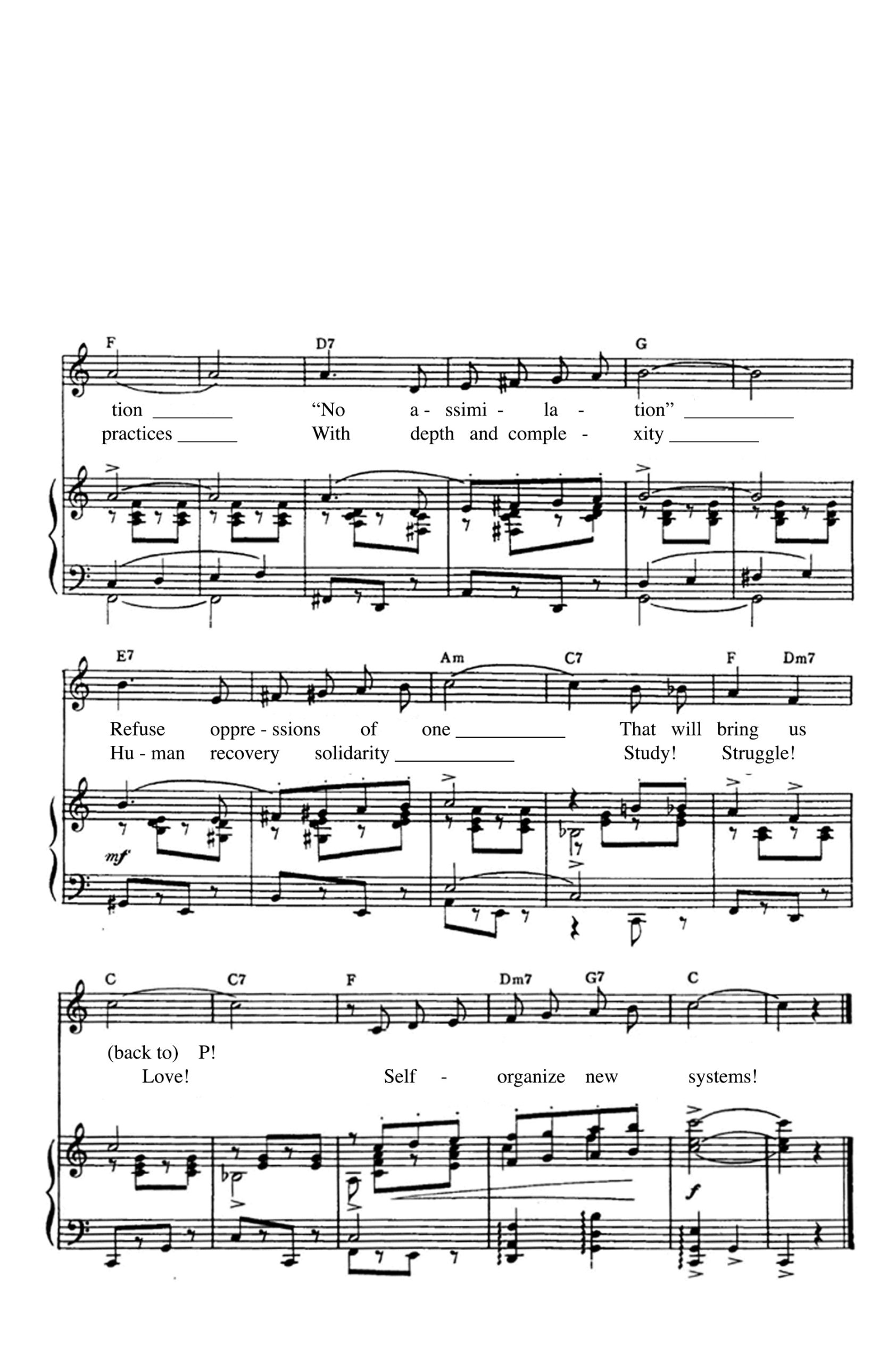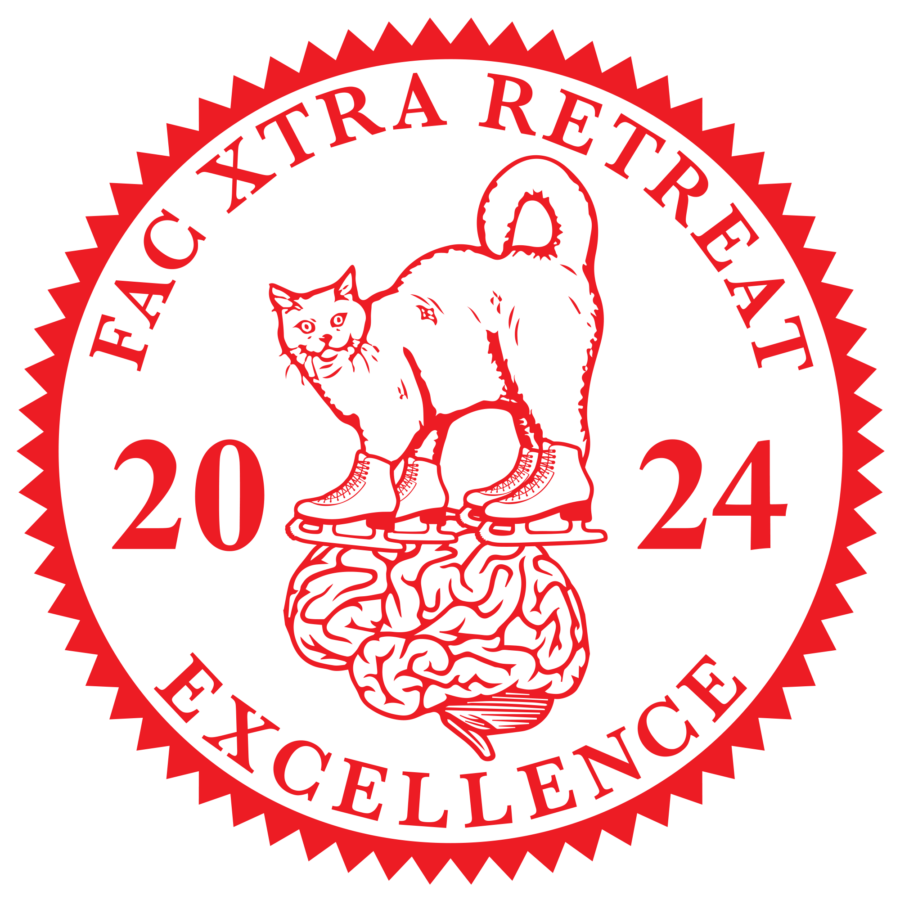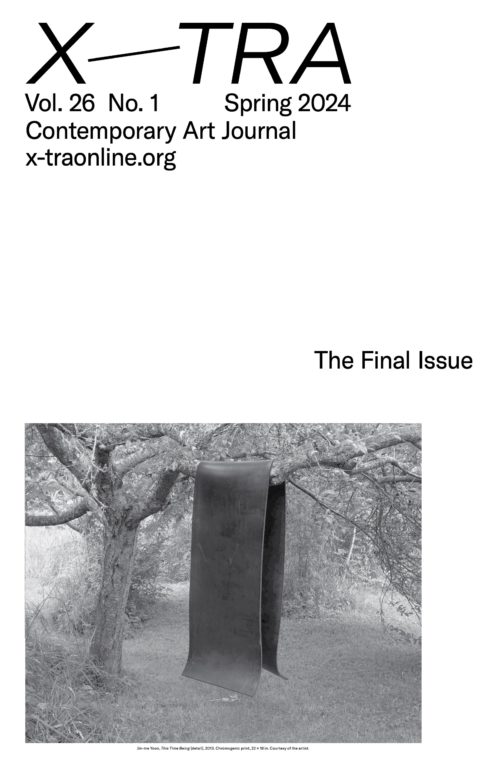Ei Arakawa-Nash, Patty Chang, Pearl C Hsiung, Amanda Ross-Ho, Anna Sew Hoy, Shirley Tse, and Amy Yao are artists that teach in various art schools and universities. Some are longtime friends and some have met more recently, but most have been aware of each other’s work for a while. In 2022, they connected in the context of the Asian American Pacific Islander Arts Network (AAPIAN), an organic group of artists and art workers based in California. Through these conversations, meetings, and events, they sidebarred around common interests and began gathering as a smaller group on Zoom and in restaurants around Los Angeles to eat food, sometimes drink whiskey, and talk shit about art, life, and teaching. Eventually, they informally formalized as FXR (Fac Xtra Retreat) and presented a performance of the same name at REDCAT, Los Angeles, on February 17 and 18, 2023. Using online academic DEI (Diversity, Equity, and Inclusion) training modules as a template, the performance was a polyphonic, satirical yet sincere variety extravaganza addressing the complex and simultaneous roles of artmaking and pedagogy while being Asian American. Combining multichannel PowerPoint projections, live band karaoke with babies, bespoke sound effects, Facetime broadcasts, interpretive roller skating, coupon drops, ChatGPT, improvised dialogues and “banter,” and a mock faculty lounge skirmish, the performance also incorporated copious physical props, including a 300-pound clay ball, a giant reversible blazer, laser-cut zeros and ones, money guns, and a professional treadmill that was later returned to Amazon. In the summer of 2023, FXR gathered for an XTRA online retreat to co-create an artists’ project for this magazine.
Audience Testimonials
“The performance conveyed so much of our concerns as AAPI educators in a non-traditional way. Unlike a panel discussion, it stayed outside of the system which we are trying to address, and brought in conversations in a way that was so much more open. Mara Goldstein said ‘If you are talking about pedagogy, why go back into these institutions to discuss the issues? There is a way to do it outside.’ The performance is the best way. Performance sabotages the info trade.”
“My cousin, who is 27, new to LA, knowing nothing about the FXR artists, was fascinated to think that artists teach, and deal with Asian American issues, and then have to run on this treadmill! That’s not a side of art she engaged in before.”
“Jarring, winging it, all of the points of tension created so much mirth and discomfort among the audience and made the performance successful. Like Martine Syms’s The African Desperate, the performance didn’t try to translate the language and jargon to a non-insider audience. Keeping the language authentic and specific made the piece resonate intellectually and emotionally.”
“With this performance, it’s okay to come with an AAPI lens, and it’s okay for people to feel disoriented. That’s a part of what we have to do when we think about dismantling white supremacy. Everyone has to rethink how they see the world.”
BANTER
Are you still wearing pajamas, you guys?
Even though I know, what the original thing was, some time has passed, and it’s cooled a little bit to me. I’m kind of like, well, we could take this on as its own thing. You know, the way the REDCAT performance was its own thing. Now FXR is addressing the print media space. I know we don’t have a lot of time, so it’s probably like, whatever, but it could be something really simple that’s actually funny and takes on the print pages in the way that we did the performance. I don’t know. That’s just what I was thinking.
How would our collaboration make sense on printed pages?
If the PowerPoint is printed on a portrait page, it’s so small you wouldn’t be able to read the text.
But it is not just a PowerPoint, we appropriate it for us to jam together. It also references the DEI training and teaching itself. During the performance, it was a script we followed.
In our performance, the PowerPoint was projected, and we performed to it The slides were satirical stereotypes, and we were able to use our bodies to play with them in time. Can text on pages perform to graphic elements?
Yeah, I think it could just be a reformatting. Thinking now, we don’t have time for things like, different paper or origami, even if it’s something like when you make the balloon, a ball. I was thinking of dimension, how there was so much simultaneity in the live performance. I feel like time and space, dimension – we were bending, upending the linearity of a training or an event.
It’s confusing to me that we even have to provide a context, to be honest, because I’m like, if it’s an artwork, then if it’s an artwork insert, then why is there a context all the time? You know what I mean, cuz like, to some degree, you go to a gallery, it’s like, yeah, sometimes the artwork is really contextualized. And other times it’s not. It’s sort of the artist’s choice, right? Like, some people have no press release, or some people have a press release that’s just a poem. And I’m like, okay, is this an artwork, or is it like an interview? I don’t know
Contextualizing it makes it worse?
Remember this slide about the dumpling? Patty said it actually happened. I love that.
Remember we were wondering if anyone would review our performance. Instead of a review, why not write the article ourselves? That is agency.
Can I back-up a little bit? The whole process started with us wanting to do a post-performance seven-way dialogue. We proposed that to different places, and X-TRA picked it up, thinking that it’s gonna be a seven-way conversation. We then met and decided using visuals would be more interesting, you know, using the PowerPoint. So we proposed it to them. And then they saw it as, WAIT, this does not really fit in a conversation section of our magazine, but it will fit in the artists’ project section. So could this be in the artists’ project section? Now, you know, it started with whether we wanted a documentation or conversation, and they looked at that, and it’s like, oh, this does not look like an artist’ project. It’s sort of been in between documentation, lacking context. That is where we are at.
Okay, so, really quickly before we end, because I gotta go too. There is something about the performance where we are kind of fucking with who’s the teacher and who’s the student, like, there’s a bit of that weirdness. So there could be something where that gets confusing, you’re not presenting yourself as a teacher, you know. Like, that prompt is to a student, theoretically. Do you see what I mean? There could be something that’s, a little disorienting. You could print that question, like, where are you from? What’s blah,blah, blah, like the classic class introduction. And then we, all of us, teachers, and our students aren’t, you know, what I mean? Like some weirdness?
Utter it. This doesn’t have to be real. You know, like, nothing is real.
How do we fuck with, you know, the teacher-student dynamic? In my classes, if we have time, I do we do this thing where two people interview each other. It’s all the same basic questions, like, What’s your favorite movie? It’s all based on this questionnaire I give them. So, it could be like, like, I introduce Pearl, and we interview each other. Then Pearl’s like, this is Amy Yao, and she does this, she enjoys this and that. And then vice versa. So, you pair up, and then you introduce each other, as an icebreaker.
I will be ice skating at the Tonya Harding Rink as part of my show. Thanks to you all for unleashing my inner showgirl.
Be like a year, you know, or however long, thinking about it. It’s temporality and it’s like aging. Is it worth thinking about?
No, I mean, unfriendly in a good way.
Well, maybe I will volunteer to be the one that has no teaching philosophy, and I will say, I like surfing. I do this or that, you know, which makes you sound more like a student, right?
Yeah, the philosophy might not be the thing, it could be whatever your introduction is, you know what I mean? You could choose to answer in that way.
Let’s not be too academic, that takes the fun out of it.
We need to evoke the DOULA.
Like the performance. Maybe rambling gibberish—equity, committee chair, search committee, meetingsmeetingsmeetings, availability, reviews, hummus, blazers, credit, clinical exhaustion, inclusion . . .
I love this fucking chaos.
Just had a flashback to six months ago, when we were in an AAPI pedagogy meeting reluctant about a deliverable, such as a panel discussion that offers answers or a conclusive model of a pro-AAPI pedagogy. Fast forward to now, we are about to have this uplifting deliverable in the form of a collaborative performance! So thrilled! Thx, Ei.
Yes, this form is like Ursula LeGuin’s carrier-bag theory of fiction as a performance. It can carry all these things, activities, can be polyphonic and webbed.
In the spirit of our project, why don’t we call this art project the, what is it, the X-TRA X-TRA faculty retreat? Like, wow, you know, we did this, I don’t know, two years ago, and the first thing was, Who is the teacher? I mean, it’s great. Yeah.
Yeah, I’m actually, Shirley, you read my mind. I was thinking something about this conversation, about trying to figure out what the fuck this thing is. Could it be an introduction? Like, I don’t know, maybe it’s this, maybe it’s that, maybe, it’s us bantering about what the stupid thing is?
It’s true. Also X-TRA X-TRA, like, “Extra, extra, read all about it.”
Let’s meet at the Mountain House! Their noodles look yummy!
I need a babysitter for my child.
Yeah, this retreat is the salve on my institutionally chapped ass.


Ei Arakawa-Nash is a Japan-born American performance artist based in Los Angeles and teaching at ArtCenter College of Design. Resonating with the recurrent histories of artistic collaborations from modern Japan, Arakawa-Nash’s performances are often created through fervent collaborations with artists (and at times their artworks) and audience members themselves.
Patty Chang is a Los Angeles-based artist and educator who uses performance, video, installation, and narrative forms when considering identity, gender, transnationalism, colonial legacies, the environment, large-scale infrastructural projects, and impacted subjectivities. She teaches at the University of Southern California in Los Angeles.
Pearl C Hsiung is a Taiwan-born artist based in Los Angeles whose painting, video, and installations summon landscapes to question human-nature dualisms and explore the speculative space of our physical, energetic, and temporal entanglement. She is an assistant professor in the School of Art at California State University, Long Beach.
Amanda Ross-Ho is an interdisciplinary artist and a professor of sculpture at the University of California, Irvine. Ross-Ho’s artistic activity originates in an archival impulse. She elevates fragments from material culture, media, and her personal autobiography into speculative monuments, archives, and tableaux, proposing reimagined ecologies and resulting in an ongoing idiosyncratic formal syntax.
Anna Sew Hoy is a New Zealand-born American artist based in Los Angeles who utilizes sculpture, ceramics, public art, and performance in order to examine the world and our relations in it. She is a professor of art at the University of California, Los Angeles, School of the Arts and Architecture.
Shirley Tse is a Hong Kong-born artist based in California. For more than three decades, the artist and longtime CalArts faculty member has created sculptural interventions that interrogate notions of place, politics, and ecology. Tse is a Guggenheim fellow and represented Hong Kong at the 58th Venice Biennale.
Amy Yao was in the nineties punk band Emily’s Sassy Lime and is a contemporary visual artist based in Topanga, California, and New York City, working in many different mediums informed by ideas of waste, consumption, and identity. Yao is a lecturer in Princeton University’s Lewis Center for the Arts.
FXR Special Thanks to: Steven Lam, Rick Noguchi, Grace Oh, Christina Valentine, Christopher Yin, AAPI Arts Network, and AAPI Arts Network Pedagogy group.


